Selecting the [Tools/Configuration] menu item or toolbar button displays the Configuration dialog. This dialog provides for general setup of Global Mapper display options.
The Configuration dialog provides the following panels allowing the modification of display options:
The General panel (pictured below) controls options for the display of vector data (areas, lines, and points) as well as position format on the status bar.
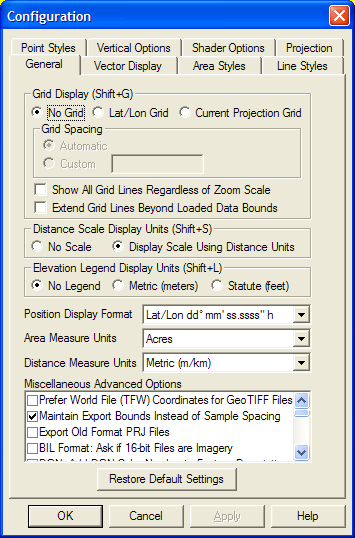
The Grid Display options allow for the control of whether or not grid lines are displayed, and if so, what projection they will be in. The No Grid option is the default and causes no grid lines to be displayed or exported. The Lat/Lon Grid options causes a grid to be displayed along even latitude and longitude lines. The Global Projection Grid option causes a grid to be displayed in the currently selected global (i.e. display) projection, which can be modified on the Projection tab.
The Grid Spacing section allows you to specify whether to allow Global Mapper to automatically determine a good grid spacing to use or to specify a custom grid spacing.
If the Show All Grid Lines Regardless of Zoom Scale option is checked, all grid lines will always be shown rather than the default behavior of only major grid lines being displayed when zoomed way out and the more minor grid lines only showing up as you zoom in.
If the Extend Grid Lines Beyond Loaded Data Bounds option is checked, the generated grid lines will extend a little bit beyond the bounds of the loaded data. Otherwise, the grid lines will stop at the edge of the smallest bounding box encompassing all loaded data files.
If grid lines are being displayed, the grid lines can also be exported to any of the supported vector export formats. The color and style of the grid lines can be modified on the Line Styles tab by modifying the styles for the "Grid Line", "Grid Line - Minor", and "Grid Line - Major" line types. You can also selectively turn off the display of any or all of the grid line types using the Filter options described above.
The Distance Scale Display options allow for the control of whether or not a distance scale is displayed on the main map when data is loaded. The Distance Measure Units selection below it then controls the units that are displayed on the scale bar.
The Elevation Legend Display Units options allow for the control of whether or not an elevation legend is displayed on the main map when elevation grid data is loaded and what units the elevation legend will be in if it is displayed. The No Legend option causes no elevation legend to be displayed. The Metric (meters) option causes an elevation legend to be displayed with various elevation values labeled in meters. The Statute (feet) option causes an elevation legend to be displayed with various elevation values labeled in feet. If the elevation legend is displayed in the main map view, you can right click on it to control various options and also save it to a BMP file.
The Position Display Format setting controls the format of the cursor latitude/longitude position display in the status bar.
The Area Measure Units setting controls what units that area measurements will be displayed in the Measure Tool and when creating new features with the Digitizer Tool.
The Distance Measure Units setting controls what units that distance measurements will be displayed in the Measure Tool and when creating new features with the Digitizer Tool as well on on the Distance Scale bar.
The Miscellaneous Advanced Options section contains options for advanced users. The following options are available:
The Restore Default Settings button will restore all Global Mapper settings from the Configuration dialog to their default values.
The Vector Display panel (pictured below) controls options for the display of vector data (areas, lines, and points).
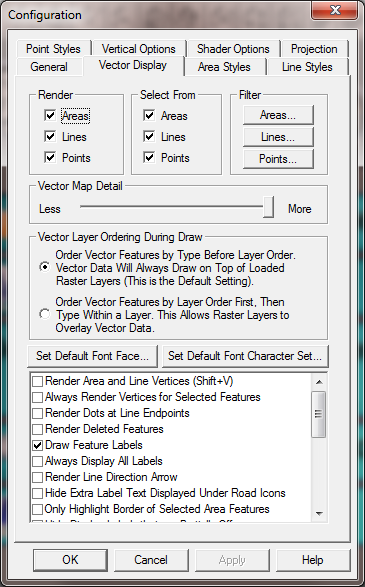
The Render section contains the settings for which types of vector features (areas, lines, or points) are to be displayed when loaded. You can use these settings to turn off an entire class of features all at once. For a finer degree of control, see the Filter section described below.
The Select From section contains the settings which determine which vector object types (i.e. areas, lines, points) the Pick Tool will consider when selecting objects.
The Filter section allows you to select which specific area, line, and point feature types you wish to display. By default, all feature types are displayed.
The Vector Map Detail setting controls how much decluttering of displayed vector data is done. This is useful when you have a large of amount of vector data loaded. For example, if you had all of the roads for an entire state loaded at once, you could slide the detail slider to the left to make minor roads been hidden until you zoomed in sufficiently far on the data. The rightmost (default) setting causes all vector data to be displayed regardless of zoom scale. This setting does not affect the display of raster or elevation data sets.
The Vector Layer Ordering During Draw settings control the order in which data from vector layers is displayed. The default setting (order by type before layer order) is that all vector data is drawn after any other loaded raster or elevation data, regardless of how the vector layers are ordered in the Overlay Control Center. All area features from all layers will be drawn first, followed by all line features from all layers, and finally all point features from all layers. Within each grouping (e.g. areas, lines, or points), the drawing order will be determined first by type, and then by layer ordering.
The second draw order option (order first by layer, then by type within a layer) specifies that the order of the vector layers in the Overlay Control Center should take precedence over all else when drawing. This means that if a vector layer is before a raster layer in the Overlay Control Center's draw order, that vector layer will draw underneath that raster layer if they overlap.
The Set Default Font Face option allow you to choose what font face should be used for all feature label displays where the font has not been explicitly set to something else for the feature.
The Set Default Font Character Set option allow you to choose what character set should be used for fonts that are still set to the default for their type. Change this to allow default display of non-European character sets, like Cyrillic (Russian) or Japanese.
The Render Area and Line Vertices option specifies whether each vertex along area and line features should be displayed with a large dot.
The Always Render Vertices for Selected Features option specifies whether each vertex along area and line features selected with the Digitizer/Edit Tool should be displayed with a large dot. Use this option rather than the Render Area and Line Vertices option above to only display vertices for features that you are actively editing in order to prevent excessive clutter on the map.
The Render Dots at Line Endpoints option specifies whether or not the start and end vertices of line features will be displayed with a large dot. You can use this instead of the Render Area and Line Vertices option if you just want to see line endpoints rather than all shape points.
The Render Deleted Features option specifies whether or not features that have been deleted by the user should be displayed.
The Draw Feature Labels option specifies turns labeling of features on or off globally. For more fine-grained control over which types are labeled, check the Area Styles, Line Styles, or Point Styles tab.
The Always Display All Labels option specifies whether or not feature labels should be allowed to overlap when drawing them on the screen. When this option is not checked (this is the default), labels that collide with other labels on the screen will be discarded until you zoom far enough in on the feature so that they can be displayed without overlapping any other labels.
The Render Line Direction Arrow option specifies whether or not a small arrow should be drawn on each line feature indicating in which direction the line vertices go. The arrow will point along the line towards the last vertex in the line.
The Hide Extra Label Text Displayed Under Road Icons option allows you to control whether or not any extra text displayed below road icons, like alternate names for the road, are displayed.
The Only Highlight Border of Selected Area Features option allows you to change the rendering style for area features selected with the Feature Info or Digitizer Tools so that only the border of the area is highlighted and the center is left unfilled.
The Mark Sides of Road with Addressing Information option allows you to have the sides of roads with recognized address numbering information to be marked with a series of parallel lines extending from the road on the side(s) with known address information. This provides a visual way to see where addressing information is available.
The Hide Display Labels that are Partially Offscreen option allows you to hide any feature labels that don't entirely fit on the screen. This can be useful when exporting vector data to a raster format and also gridding the export into multiple pieces. This option should allow a seamless result in that case.
The Add MODIFIED_DATE to Modified Vector Features option controls whether or not a MODIFIED_DATE attribute is automatically added to vector features when they are changed in some way.
The Iconize Road Names on Import (Some Formats) option controls whether or not the specified name for road line types is checked on import to see if it should result in an iconized road name display (such as for interstates and major highways). This is only done for formats which do not already have their own built-in iconization (such as Tiger/Line and USGS DLG files). For example, this will work for formats like Shapefiles and MapInfo MIF/MID files (among others).
The Fix Line Label Position on Longest Segment option controls whether or not the label displayed for line features should move around to always be centered on the longest on-screen segment (the default unchecked behavior) or should remain fixed on the center of the longest segment of the line, regardless of whether it is on-screen or not. Checking this can prevent your line labels from jumping around as you zoom in and out, but can result in a lot of unlabeled lines if you zoom in too far.
The Only Snap to Area and Line Vertices by Default option controls whether or not the snapping behavior of the Digitizer Tool will snap to anywhere on existing area and line vertices (the default unchecked behavior) or will only snap to vertices on area and line features. Holding down the 'V' key when drawing will toggle this behavior.
The Only Display Area Labels when Completely Inside Area option allows you to easily disable the display of any area label when that label is not completely contained within the area feature that it is labeling. This is useful to keep area labels from displaying until you are zoomed in far enough on the area for a label to be appropriate.
The Don't Add Measure Attributes to New Features option allows you to disable the automatic adding of measure attributes, like LENGTH, PERIMETER, ENCLOSED_AREA, etc. to new area and line features created with the Digitizer Tool.
The Make Duplicate Vertex Turn Off Area Border Segment allows you to use duplicate area vertices to turn segments of the area border on and off. This is known as Pen Up/Pen Down display. How it works is that the border pen is on (down) at the start of the border. Whenver a duplicate vertex is encountered, then pen it turned off for the next segment. So if for example you had vertex 1, then a duplicate vertex 2 and 3, then non-duplicate vertices 4 and 5, you would get a border drawn from vertex 1 to vertex 2, then it would turn off for 3-4, then be drawn again for 4 onto the end.
The Disable Snapping to Features in the Digitizer Tool option allows you to disable automatic snapping to nearby features when drawing in the Digitizer Tool. If you check this option then snapping will be disabled by default and holding down the ALT key can be used to enable snapping (the default behavior is the reverse).
Built-In Area Types and Styles - A graphical reference guide to the area types and border/fill styles built-in to Global Mapper.
The Area Styles panel (pictured below) allows the user to configure how areas of a given type will be displayed in Global Mapper. The area fill and border style and color can be modified on a type-by-type basis. You can also use the Add Custom Fill Pattern option to provide your own image to use as a fill pattern. For transparent or translucent patterns, use a transparent PNG format image file when creating the custom fill pattern.
With the Transparency slider users can make solid filled areas partially see-through (translucent) in order to see data underneath the area. In addition, the Show Labels for Areas of This Type When Present option allows users to turn area labels off on a type-by-type basis.
The New Type button allows the user to create a new area feature type and specify how it should be displayed. The Edit Type button allows the user to edit area types that were previously created with the New Type button, and the Delete Type button allows the user to remove area types that were previously created with the New Type button. With the Attributes button you can specify a set of default attributes and values to use for new features of this type created using the Digitizer Tool.
If you right click on the list of types, a menu will appear allowing you to save and restore your style settings using a style file. This provides an easy way to setup a set of styles to use, then restore them at a later date for use with a particular set of data.

Built-In Line Types and Styles - A graphical reference guide to the line types and drawing styles built-in to Global Mapper.
The Line Styles panel (pictured below) allows the user to configure how lines of a given type will be displayed in Global Mapper. The line style, width, color, and label font can be modified on a type-by-type basis. When selecting a line width, you can choose a fixed width in screen pixels, which means that the line will draw the same width regardless of your zoom level, or you can choose the option to specify the line width as a New Fixed Width in Meters. When you do that your line will be drawn at a given number of meters in width, which means it will get thicker as you zoom in and smaller as you zoom out to maintain the same width in ground units.
In addition, the Show Labels for Lines of This Type When Present option allows users to turn line labels off on a type-by-type basis. The Display Roads As Fat Lines When Zoomed In option allows users to turn on/off the "fattening" of road lines when zoom in tight on them.
The New Type button allows the user to create a new line feature type and specify how it should be displayed. The Edit Type button allows the user to edit line types that were previously created with the New Type button, and the Delete Type button allows the user to remove line types that were previously created with the New Type button. With the Attributes button you can specify a set of default attributes and values to use for new features of this type created using the Digitizer Tool.
If you right click on the list of types, a menu will appear allowing you to save and restore your style settings using a style file. This provides an easy way to setup a set of styles to use, then restore them at a later date for use with a particular set of data.
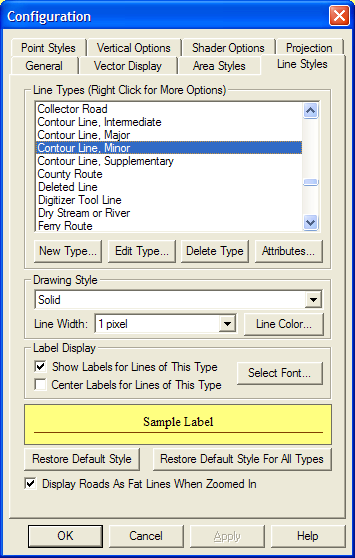
Built-In Point Types and Symbols - A graphical reference guide to the point types and symbols built-in to Global Mapper.
The Point Styles panel (pictured below) allows the user to configure what symbol will be used to display points of a given type and at what angle, if any, to rotate the symbol when displaying it on the map. Symbols can be rotated relative to either the map display (where 0 degrees is always straight up) or relative to true north, where 0 degrees always points directly to the North Pole. Rotated symbols are good for use in geology maps and for adding things like north arrows to your maps.
You can also press the Scale button to scale a point symbol to make it larger or smaller. For example, to double the size of a symbol use a scale of 2.0, whereas to make a symbol half its original size, use a scale of 0.5. You can also specify a symbol size in meters. This will automatically scale the point so that it is always the specified number of meters tall on the map regardless of zoom level.
The symbol selection list also includes several option at the top of the list to select symbols of common shapes, like dots, squares, diamonds, etc. with a user-specified size and color.
In addition, the Show Labels for Points of This Type When Present option allows user to turn point labels off on a type-by-type basis. The Custom Symbols section allows users to create new symbols from their own bitmap and icon files which they can then use as the symbol to display for a given type.
The New Type button allows the user to create a new point feature type and specify how it should be displayed. The Edit Type button allows the user to edit point types that were previously created with the New Type button, and the Delete Type button allows the user to remove point types that were previously created with the New Type button. With the Attributes button you can specify a set of default attributes and values to use for new features of this type created using the Digitizer Tool.
If you right click on the list of types, a menu will appear allowing you to save and restore your style settings using a style file. This provides an easy way to setup a set of styles to use, then restore them at a later date for use with a particular set of data.
The Custom Symbols section allows you to add new point symbols that will be available for display from your own files. This includes support for transparent symbols from PNG, ICO, GIF, and 32-bit alpha BMP files, as well as symbols from JPG images. You can also add vector symbols from EMF, DXF and GM_SYM (Global Mapper Symbol) files. GM_SYM files are simply ASCII text files that the File->Open Generic ASCII Data File menu command couuld load, with 0,0 being the center of the symbol and the coordinates specified as pixels, with X increasing to the right and Y increasing to the top of the symbol. Vector symbols will scale much more cleanly than symbols based on images.
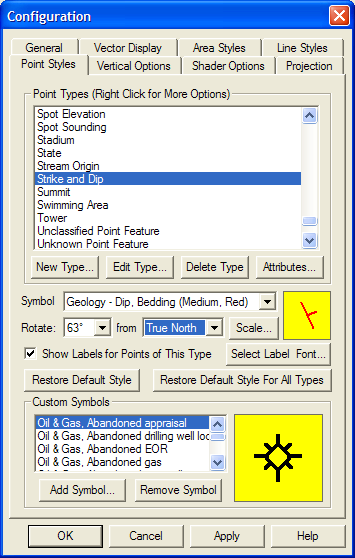
If you press the Select Label Font... button, the font selection dialog (pictured below) for the selected point type will appear. This dialog allows you to select the font to use for the point, as well as set up other label display options for the point, including where to position the label relative to the point, what angle (if any) to rotate point labels at, how to fill the background for the labels, and whether or not to display the labels at a fixed height in ground units rather than a fixed font size in pixels.
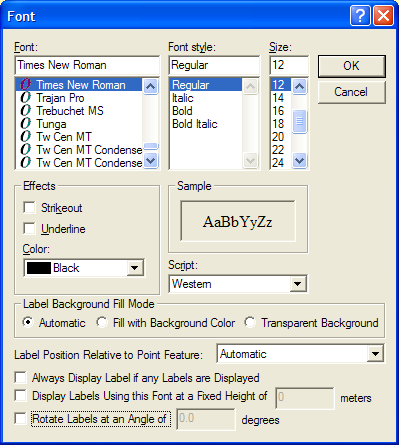
The Vertical Options panel (pictured below) controls options for the display of elevation data.
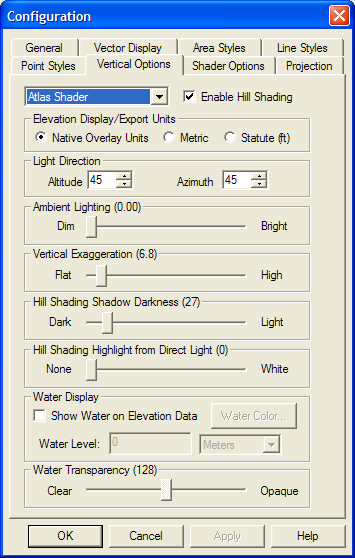
The Shader selection box allows for the selection of the algorithm used to color and shade any loaded elevation data. The following shading algorithms are available:
Use the Enable Hill Shading option to view elevation data as shaded relief. With this option off, the map appears flat, with elevations distinguished by color only. With it on, shadows are generated using the loaded elevation data along with the remaining settings on this panel.
The Elevation Display Units option allows you to modify the units that elevations will be displayed in on the status bar as you move the cursor over loaded elevation data.
The Lighting Direction options set the position of the light source (the "sun") for performing hill shading. Note that cartographic azimuth and altitude are used. This means that 0 azimuth means the sun is to the north, 90 azimuth means the sun is to the east, and so on. An altitude of 90 means that the sun is directly overhead, while an altitude of 0 means the sun is on the horizon.
Use the Ambient Lighting to brighten up dark looking data sets or dim bright looking data sets.
The Vertical Exaggeration setting is used to control the exaggeration of relief features.
The Hill Shading Shadow Darkness setting is used to control how dark that hill shading is allowed to make shaded areas. By default, the value of 0 allows shaded areas to go all the way to black. By moving this slider to the right you can cause shadowing to be capped in high relief areas, thus allowing the use of other controls to better bring out detail in low-relief areas.
The Hill Shading Highlight from Direct Light setting is used to display a whitened highlight area in terrain areas that are getting direct sunlight based on the lighting angle selected. The slider controls the amount of whitening highlight applied to those direct sunlight areas.
To enable the display of water on elevation data sets, check the Show Water On Elevation Data option.
The Water Transparency controls the clarity of displayed water if configured to display water. Clearer water shows more underlying relief to show through, while opaque water allows none.
The Water Level setting controls the level at which water is displayed. The default is set at an elevation of 0 meters above sea level. Use this to simulate different flood and sea level change scenarios.
The Water Color options allows you to set the color of the water. The default is blue.
The Shader Options panel (pictured below) controls options for the display of elevation data using the daylight, gradient, slope, and HSV shaders (described above).
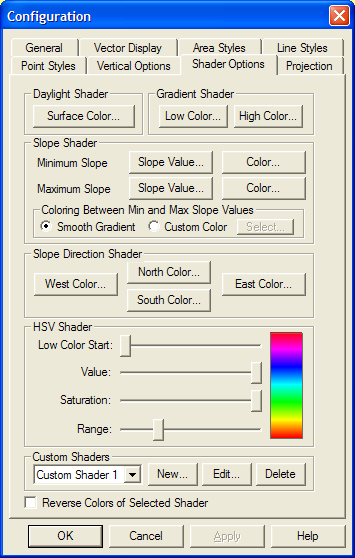
The Custom Shaders section allows the user to manage any custom shaders that they may have. Custom shaders allow the user to control exactly how elevation data is rendered so that the desired result can be obtained.
Pressing the New... button displays the Custom Shader dialog (pictured below) which allows the user to create a new custom shader. Pressing the Edit button display the same dialog, allowing the user to edit the currently selected custom shader. The Delete button removes the currently selected custom shader.
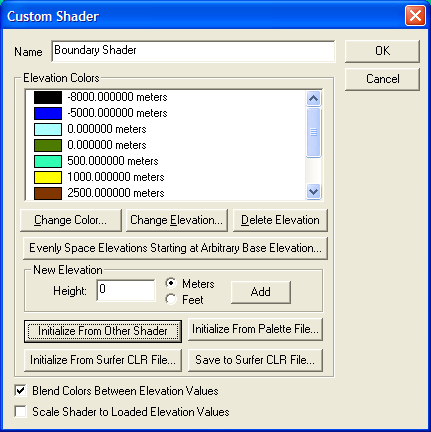
The Custom Shader dialog allows the user to specify how they want elevation data to be rendered. The Name field provides a place to enter the name to associate with the shader to allow the user to select it. The Elevation Colors section display the elevations and their color values associated with the custom shader. Pressing the Change Color and Change Elevation buttons allow the user to change the values associated with the current elevation selected in the Elevation Colors list. The Delete Elevation button allows the user to delete the currently selected elevation. New elevations can be added by entering the elevation (in the currently selected units) and pressing the Add button.
The Evenly Space Elevations Starting at Arbitrary Base Elevation button will allow you to quickly populate the list of elevation values with a series of evenly spaced values starting at some specified elevation. You can then assign the colors as desired after that. For example, you could use this to quickly populate the list with all elevations from 0 meters to 5000 meters with an elevation every 500 meters, then modify those as desired.
The Initialize from Other Shader button will allow you to initialize the list of color/elevation pairs to those used by either the Global Shader built into Global Mapper or another user-created custom shader. This allows users to easily create a slightly modified version of an existing shader if they'd like.
The Initialize from Palette File button allows you to initialize the list of color/elevation pairs from a color palette file in any recognized format (like a comma-delimited file of R,G,B components on each line). Since palette files don't contain elevation values, the elevations will be incremented by one for each color and set to automatically scale the colors between loaded elevation values.
The Initialize from Surfer CLR File button allows you to initialize the list of color/elevation pairs with a a CLR file created by the Surfer application by Golden Software. You can use the Save to Surfer CLR File button to save your custom shader to a CLR file. This is useful for making copies of a custom shader and providing them to other users.
Elevations shaded with a custom shader will use the color specified for each elevation value. Any elevation values between two elevation/color values will be a blend of the two bounding colors if the Blend Colors Between Elevation Values option is checked. For example, if an elevation of 500 meters was set to black and an elevation of 1000 meters was set to white, an elevation of 750 meters would be colored a medium shade of gray. Any elevations below the minimum specified elevation will use the same color as the minimum elevation. The reverse is true for any elevations over the maximum elevation. If the blend colors option is not checked, any elevation between two elevation values will be set to the color associated with the lower of the elevation values.
If you would like the elevation values selected to scale to the elevation range of the currently loaded data rather than stay at fixed elevation values, check the Scale Shader to Loaded Elevation Values. This will make your shader behave similar to most of the built-in shaders, like the Atlas or Color Ramp shaders. For example, if you check this option and specify that an elevation of 0 meters is blue and 1 meter is red, and the actual loaded data has a range of 100 meters to 500 meters, then 100 meters will be blue and 500 meters will be red, with the values gradually shaded in between (if you have the blend colors option checked).
The Projection panel (pictured below) is used to modify the projection and datum that the currently loaded data is displayed in.
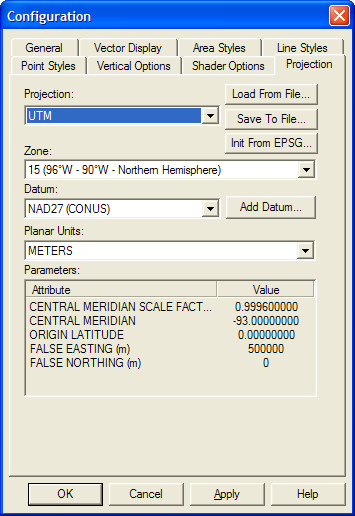
Use the Projection pull-down menu to select the projection you wish to view the currently loaded data in. The Geographic projection is really the absence of a projection. It is just a linear mapping of latitude/longitude to a grid. For a good description of most of the other supported projection systems and a discussion of the tradeoffs in using various projections, we suggest visiting http://www.progonos.com/furuti/MapProj/Normal/TOC/cartTOC.html.
The Datum pull-down is used to select the datum to use in association with the projection. The most commonly used datums are WGS84, NAD27, and NAD83. If you find that the datum that you need is not available, you can use the Add Datum button to add your datum. When that button is pressed, the Create New Datum dialog (pictured below) is shown, allowing you to enter the parameters for either a 3-parameter Molodensky datum transformation or a 7-parameter Bursa-Wolfe datum transformation, or even specify a transformation defined by a text file with a list of control points.
If you choose the Custom Shift Based on Control Point File option, the text file that you select should have a series of lines defining the mapping from a lat/lon coordinate in the new datum and the corresponding lat/lon value in WGS84. This is a very easy way to define a datum if you don't know any transformation parameters, but do know the WGS84 coordinates for at least 2 coordinates in the new datum. The format of each line would be as follows:
deg_longitude_in_new_datum,deg_latitude_in_new_datum,deg_longitude_in_WGS84,deg_latitude_in_WGS84
The Abbreviation field is what will be displayed for the datum name in the status bar. If your datum uses a prime meridian other than Greenwich, enter the longitude of the meridian used (relative to Greenwich) in the Prime Meridian entry box.
The datum information will be stored in the custom_datums.txt file in the Global Mapper Application Data folder (see the Help->About dialog for the location of this folder), so to share your datums just copy that file to that folder on another user's computer. If a needed ellipsoid is not built in to Global Mapper, use the Add Ellipsoid button to add a new one or Edit Ellipsoid to edit an existing custom ellipsoid definition.
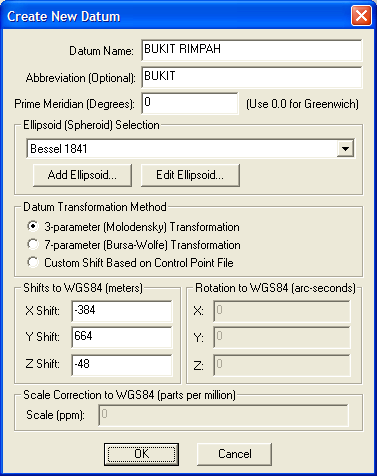
The Planar Units pull-down select the ground units to use with the projection.
The Zone selection allows you to select the zone for use with the UTM, State Plane, Gauss Krueger, and other zoned projections.
For those projections that require additional parameters to fully define them, the Attributes table allows you to enter the values for each applicable parameter.
You can save the currently selected projection to a PRJ file using the Save to File button. Previously saved PRJ files can be loaded using the Load from File button. By default, the PRJ file will be saved in the newer WKT (well-known-text) format used by most products. There is an Advanced Option on the General tab of the Configuration dialog allowing the older ESRI PRJ format to be exported instead if you would like. If for some reason a WKT-representation of the projection cannot be generated, the old ESRI PRJ format will be written out instead.
The Init From EPSG button allows you to initialize a projection definition based on a numeric EPSG projected coordinate system definition. There are numerous built-in EPSG code definitions, but by no means is there an exhaustive set. You can add your own EPSG code definitions (or modify built-in ones) by modifying the epsg_codes.txt file installed in your Global Mapper installation folder. The format is described in the file header. You must re-start Global Mapper after changing this file for the changes to have any effect.